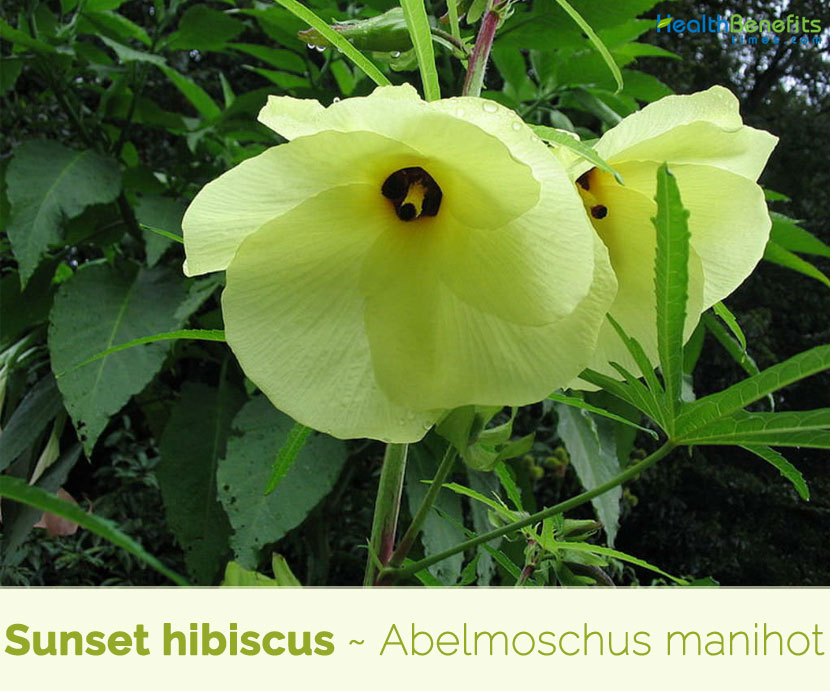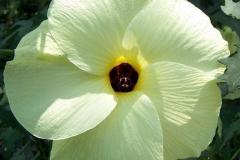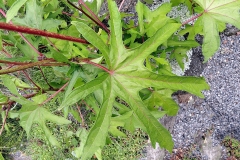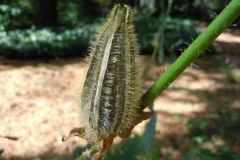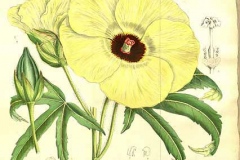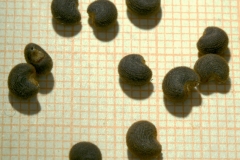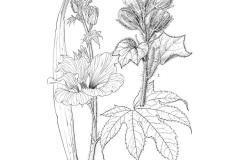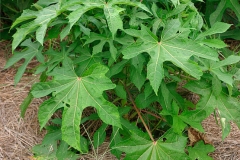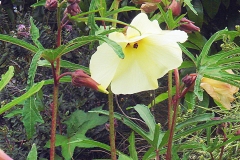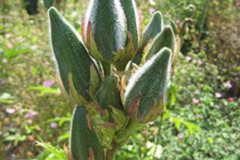| Sunset hibiscus Quick Facts |
| Name: |
Sunset hibiscus |
| Scientific Name: |
Abelmoschus manihot |
| Origin |
Southeast Asia, but an ancient introduction to Melanesia and from Fiji to Western Polynesia |
| Shapes |
Beaked, hairy, oblong and dehiscent capsule 3.5-6 cm long and 2-2.5 cm wide |
| Health benefits |
Beneficial for chronic bronchitis, toothache, Acid Reflux, Indigestion, cough and breathlessness, Hysteria, Libido, cuts and wounds |
Abelmoschus manihot or sunset muskmallow often known as Sweet Hibiscus, Edible Hibiscus, is a large annual or perennial flowering plant in the family Malvaceae. It was previously considered a species of Hibiscus, but is now classified in the genus Abelmoschus. The plant is native to Southeast Asia, but an ancient introduction to Melanesia and from Fiji to Western Polynesia. It is a very popular green vegetable or spinach in Vanuatu, Fiji and Tonga. It is a minor crop and less popular in Samoa and Cook Islands. It is found to grow extremely well in Fiji, Vanuatu, Samoa, Cook Islands and Tonga.
Genus name is believed to come from the Arabic abu-l-mosk in reference to the smell of the seeds. The specific epithet manihot refers to the genus Manihot. The common name muskmallow refers to the seeds, which have a musky odor and have been used in perfumery. Sweet Hibiscus, Edible Hibiscus, Palmate-leaved Hibiscus, Sunset Muskmallow, Sunset Hibiscus, Hibiscus Spinach, Lettuce Tree and Queensland greens, Yellow hibiscus, manioc hibiscus, Manihot-mallow and aibika are few of the popular common names of the plant. Flowers are attractive to butterflies and other pollinators. Large yellow flowers are very ornamental; the importance of this plant is that it is one of the world’s most nutritious leafy vegetables because of its high protein content. Leaves of sunset muskmallow are tender, sweet and edible, and impart a mucilaginous texture to dishes when cooked. Deer tend to avoid this plant.
Plant Description
Sunset hibiscus is an erect, quick growing; deciduous, upright, perennial subshrub that grows up to 10 feet (3 m) tall and up 4 feet (1.2 m) wide with upright, lightly hairy stems and short side branches. The plant is found growing in wasteland, humid rocky hillsides, grasslands, stream banks, and disturbed sites. The plant has adventitious and fairly shallow root with most of the roots in the top 30-40 cm of the soil. A single central stem up to 2 cm in length with short branches contain mucous canals and often also mucous cavities.
Leaves
Leaf is palmately lobed, crenate or oblong ovate, smooth and often with an even with a fairly prominent midrib. Leaves are 10-40 cm long and broad with 3-7 lobes, the lobes are very variable in depth from basely lobed to cut almost to the base of leaf, which is more or less scab rid and hairy, ovate, acute or obtuse, sometimes cordate, alternately or stipulately. Petiole is 3-25 cm long; stipules are filiform or lanceolate, 5-12 mm long. Leaf-blade is linear, lanceolate, cordate or deeply lobed or parted with 3-7 segments, color varying from light to dark green through red to purple.
Flowers
Flowers of this family are 4-8 cm in diameter with white to yellow petals, usually rolled up together in a bud or dying. The stamens and style form a long tube protruding from the center of the flower with purple color. Flowers are usually 3–4-fascicled, axillary, cymed, and rarely solitary on the stem. The flowers are also hermaphrodite, often arranged on racemes with a tuft of hairs at the apex. The pedicles are less than 2.5 cm. long, axillary and clustered at the ends of the branches, stout, sometimes with a few prickles. The hibiscus-like flowers are a brilliant lemon color with deep purple centers and long pedicels at the apex of the plant. Flowers sprout in the warmer months and they are pollinated by insects with variable levels of cross-fertilization. The petals can be added to salads or used in cooking. The large yellow flowers are very ornamental and, this plant is very important because that it is one of the most nutritious leafy vegetables in the world because of its high protein content. Flowering normally takes place from July to September.
Fruit
Fertile flowers are followed by beaked, hairy, oblong and dehiscent capsule, 3.5-6 cm long and 2-2.5 cm wide, containing numerous pubescent seeds. Fruit is a loculicidal capsule. Ovary with 3–5 (or 10) fused carpels; style branches as many as ovary locules. Filament tube with anthers inserted along length, apex 5-toothed or truncate, very rarely with anthers. Ovary and capsules are 6–10-loculed. Schizocarp separating into a mericarps.
Seed
Seed capsule is inside the flower, with five or more parts joined together. The seeds may be hairy, rounded, flat disc or even a berry. Seed can be sown at the beginning of spring in a warm greenhouse if necessary and should germinate within two weeks. Seeds have a sweet, flowery, heavy fragrance similar to that of musk. When the seedlings are large enough to handle, they can be pricked out into individual pots and planted out after the last expected frosts. The seeds are sub-reniform black and musk-scented.
https://www.youtube.com/watch?v=hktkfalZ-Vo
Traditional uses and benefits of Sunset hibiscus
- Bark is said to be emmenogogue.
- Paste of the bark is used to treat wounds and cuts, with new paste being applied every 2 – 3 days for about 3 weeks.
- Root juice is warmed and applied to sprains in Nepal.
- Juice of the flowers is used to treat chronic bronchitis and toothache.
- Abelmoschus Manihot provides relief from Acid Reflux.
- Seeds of this herb regulate the proper functioning of the Stomach and provide strength to it.
- It improves the digestive system and prevents Indigestion.
- It expels gas from the stomach and Intestine and also prevents Bloating.
- It prevents the unpleasant feeling in the stomach to prevent Nausea and Vomiting.
- It relieves from bronchitis causing cough and breathlessness.
- Its seeds boost up the stamina and immune system.
- It shows diuretic properties and flushes out bad toxins and the excess amount of water from the body through urine.
- It provides relief from the irritation of the mucous membranes, as it is a demulcent.
- Bark juice helps to lessen the swelling and muscle sores.
- It provides relieve from panic symptoms of Hysteria.
- Thick application of its bark is used to heal open Wounds and Cuts.
- This herb has the aphrodisiac action to increase Libido. It provides strength to the sexual organs for pleasure during sex.
- Extracted flower juice provides relieve from a toothache.
- Roots, seeds, and aerial parts of the plant are widely used in traditional medicine for the treatment of chronic bronchitis and, tooth-ache, a paste of bark is used to treat cuts and wounds.
Ayurvedic Health benefits of Sunset hibiscus
- Wounds: Blend few fresh barks of Sunset hibiscus with few amount of water. Apply this paste to your open Wounds. Repeat this treatment for thrice a week.
- Cuts: Apply the paste made from Sunset hibiscus bark to fresh Cuts. It works as an antiseptic on open sores.
- Muscle Sprains: Grind 2 to 3 Sunset hibiscus roots with a glass of fresh water to extract out the juice. Drink this juice daily once a day to reduce Muscle Sprains.
- Bronchitis: Extract out a glass of juice from Sunset hibiscus flowers. Drink it regularly to get relieve from Bronchitis.
- Toothache: Drink a glass of Sunset hibiscus flowers juice regularly. It relieves from Toothache.
References:
https://www.itis.gov/servlet/SingleRpt/SingleRpt?search_topic=TSN&search_value=21771#null
https://npgsweb.ars-grin.gov/gringlobal/taxonomydetail.aspx?id=621
https://pfaf.org/user/Plant.aspx?LatinName=Abelmoschus+manihot
https://www.cabi.org/isc/datasheet/27123
https://www.missouribotanicalgarden.org/PlantFinder/PlantFinderDetails.aspx?taxonid=368543&isprofile=0&
https://plants.usda.gov/core/profile?symbol=ABMA9
http://mgb.cimmyt.org/gringlobal/taxonomydetail.aspx?id=621
http://www.theplantlist.org/tpl1.1/record/kew-2609599
http://www.flowersofindia.net/catalog/slides/Sweet%20Hibiscus.html
https://uses.plantnet-project.org/en/Abelmoschus_manihot_(PROSEA)
https://indiabiodiversity.org/species/show/228567
https://en.wikipedia.org/wiki/Abelmoschus_manihot
https://gd.eppo.int/taxon/HIBMA
Comments
comments


